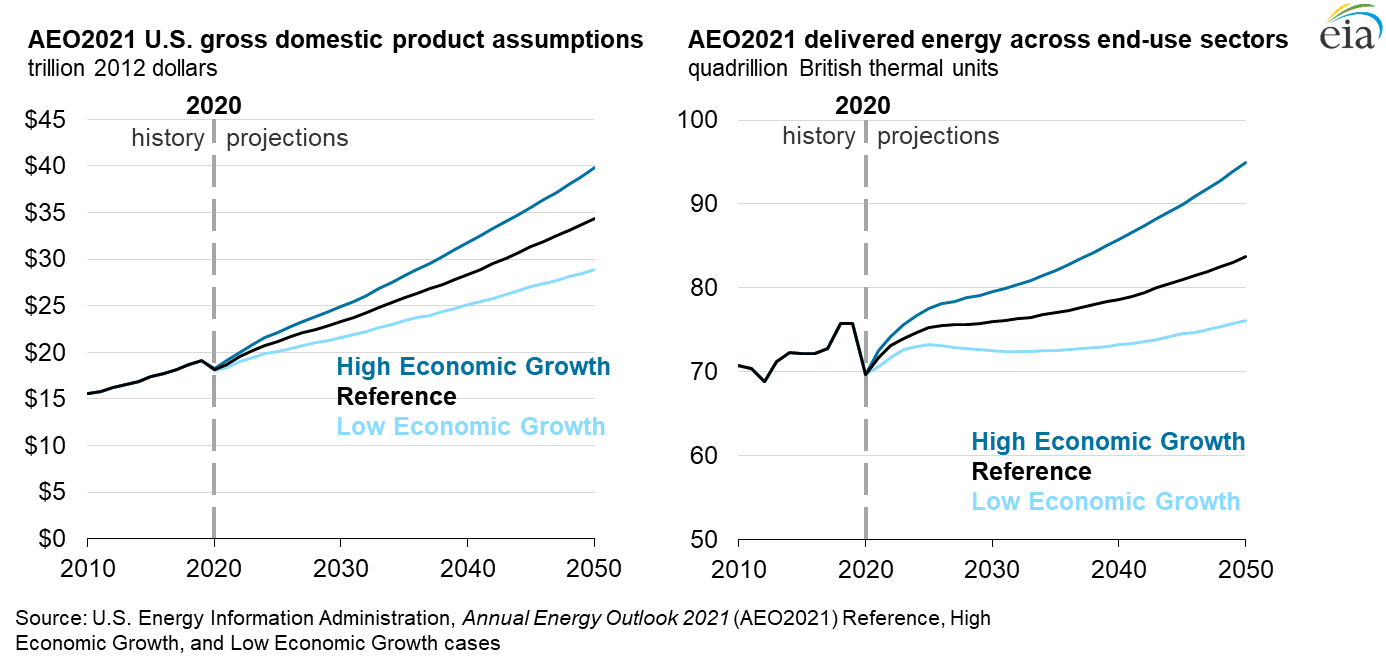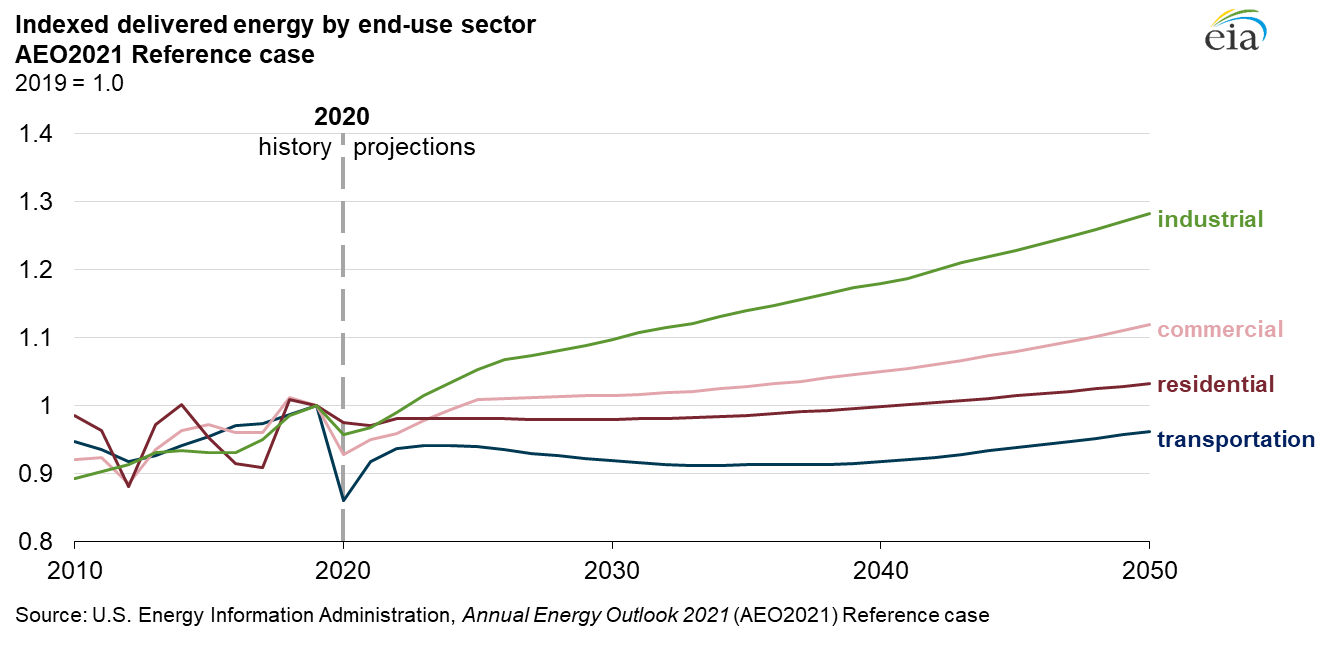
- Key takeaways from the Reference case and side cases
- The Annual Energy Outlook 2022 explores long-term energy trends in the United States
- What is the AEO2022 Reference case?
- What are the side cases?
- Motor gasoline remains the most prevalent transportation fuel despite electric vehicles gaining market share
- Energy-related carbon dioxide (CO2) emissions dip through 2035 before climbing later in the projection years
- Energy consumption increases through 2050 as population and economic growth outweighs efficiency gains
- Electricity continues to be the fastest-growing energy source in buildings, with renewables and natural gas providing most of the incremental electricity supply
- Electricity demand grows slowly across the projection period, which increases competition among fuels
- Renewable electricity generation increases more rapidly than overall electricity demand through 2050
- Battery storage complements growth in renewables generation and reduces natural gas-fired and oil-fired generation during peak hours
- As coal and nuclear generating capacity retire, new capacity additions come largely from wind and solar technologies
- U.S. production of natural gas and petroleum and other liquids rises amid growing demand for exports and industrial uses
- Driven by rising prices, U.S. crude oil production in the Reference case returns to pre-pandemic levels in 2023 and stabilizes over the long term
- Refinery closures lower domestic crude oil distillation operating capacity, but refinery utilization rates remain flat over the long term
- Consumption of renewable diesel increases as a share of the domestic fuel mix
Energy consumption fell faster than gross domestic product in 2020, and the pace at which both will return to 2019 levels remains uncertain
Delivered energy consumption and gross domestic product decreased in 2020

The 2020 downturn in the U.S. economy stems from a series of demand shocks, both direct and indirect, that have resulted in large part from responses to the COVID-19 pandemic. Demand for energy delivered to the four U.S. end-use sectors (residential, commercial, transportation, and industrial) decreased to 90% of its 2019 level in 2020; a steeper decline than seen in real GDP. Compared with the financial crisis of 2008, the COVID-19-related decline in the total demand for delivered energy is about 70% larger. In the AEO2021 Reference case, EIA projects that U.S. energy demand takes until 2029 to return to 2019 levels
Projections in AEO2021 focus on key factors driving longer-term demand for energy: growing economy and population; increasing use of renewables; increasing consumption of natural gas and electricity; and changing technology, behavior, and policy that affects energy efficiency in vehicles, end-use equipment, and lighting. These factors extend beyond the uncertainty resulting from the COVID-19 pandemic. The AEO2021 economic growth side cases provide alternative assumptions that reflect the uncertainties in the future growth of the U.S. economy. The economic growth cases also show the fastest and slowest rates of return to the 2019 level of total U.S. energy demand: in 2024 in the High Economic Growth case and in 2050 in the Low Economic Growth case, compared with 2029 in the Reference case.

Responses to the pandemic decreased energy consumption in the transportation sector more than in the other end-use sectors
In the Reference case, energy consumption in the transportation sector remains lower than its 2019 level for the entire projection period because travel greatly decreased in 2020 as a result of lockdowns, and assumed improvements in fuel economy offset projected resumed travel growth. Responses to the COVID-19 pandemic including mobility restrictions, limitations on nonessential travel, and increased working from home greatly reduced long- and short-distance U.S. travel demands in 2020 compared with 2019. In the Reference case, U.S. passenger air travel demand decreases by nearly two-thirds in 2020 and returns in 2025 to 2019 levels; bus passenger travel demand decreases by nearly half in 2020 and returns in 2031 to 2019 levels; and light-duty vehicle (LDV) travel returns to 2019 levels by 2024.
As rising economic activity results in increased travel demands that surpass 2019 levels, energy consumption in aviation (excluding military use) to move passengers and goods across the world returns to its 2019 levels by 2030. However, energy consumption by light-duty and heavy-duty vehicles remains lower than 2019 levels for the entire projection period. Although travel demands increase for most modes, assumptions of increasing fuel efficiency slow growth in energy consumption. Energy consumption decreases in the Reference case because of the market-based adoption of energy efficiency technologies in new vehicles and the increasingly stringent federal fuel economy standards through for new light-duty vehicles (through 2026) and heavy-duty vehicles (through 2027). Efficiency improvements fully offset the consumption growth from LDV travel growth through 2043 and partially offset the consumption growth from heavy-duty vehicle travel growth through 2036. Continued growth of on-road travel increases energy use later in the projection period because the travel demand for both light- and heavy-duty vehicles outpaces fuel economy improvements.
Industrial energy consumption is projected to return to 2019 levels more rapidly than in other sectors
By 2025, industrial output in the United States returns to 2019 levels in the Reference case, although EIA projects that specific industries will return to 2019 levels at different rates. Industrial energy consumption also declined in 2020, but EIA projects it to return to its 2019 levels by 2023, which is even faster than output growth and yields an increase in energy intensity in the near term. The U.S. industrial sector consumes more energy than any other end-use sector, and its energy use is projected to grow nearly twice as fast as any other end-use sector between 2020 and 2050. Metal-based durables, primary metals, and refining, all sensitive to net exports, contributed significantly to the 2020 decline in delivered energy consumption, while energy-intensive manufacturing and non-manufacturing industries drive the return to 2019 levels.
Energy consumption in buildings is least affected
Consumption of energy in commercial buildings declined in 2020, resulting in the largest single-year decline in buildings sector delivered energy consumption since 2012. However, in the Reference Case, energy consumption in commercial buildings returns to 2019 levels by 2025. Commercial and residential energy intensities—the ratio of delivered energy consumption to floorspace or building counts—suggest shifts in demand from increased working from home and videoconferencing in 2020 compared with 2019, although the increase in demand for energy by the residential sector is tempered by lower space heating needs resulting from a relatively warm 2019–2020 winter.
Consumption of energy in residential buildings remains stable through the short term because because working from home is moderating the effects of the economic downturn. Although Reference case energy consumption grows more slowly in residential buildings than in any other end-use sector between 2020 and 2050, increases in residential demand for cooling and electronic equipment offset efficiency improvements in many types of equipment, resulting in small increases in delivered energy consumption.
Following the historic demand shock in 2020, total energy demand in the U.S. economy returns to 2019 levels by 2029 in the Reference case, by 2024 in the High Economic Growth case and, and only by 2050 in the Low Economic Growth case.
-
Additional information:
-
- Monthly Energy Review
- Short term Energy Outlook
- Changing demand for petroleum products has led to operational changes at U.S. refineries
- Demand for jet fuel in the U.S. is recovering faster than in many other markets
- EIA forecasts U.S. petroleum demand will remain below 2019 levels for several more months
- Stay-at-home orders led to less commercial and industrial electricity use in April
-
Previous Editions of the AEO
-
Documentation and Assumptions